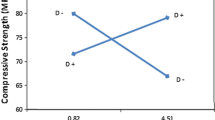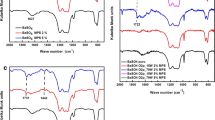Abstract
In cemented arthroplasties, the two-part self-curing acrylic bone cement is currently the only material used for anchoring the total joint replacement to the contiguous bone. In virtually all commercially available formulations of this cement, the agents used for the initiation and activation/co-initiation of the radical polymerisation reaction are benzoyl peroxide (BPO) and N, N dimethyl-para-toluidine (DMPT), respectively. There are no reports in the open literature on the rationale for the amounts of these and other constituents in the formulations of the cement. Given the concerns that have been raised in the literature regarding the effect of residual DMPT on the body, it is important to keep the starting amounts of BPO and DMPT as high and as low, respectively, as possible. In the present work, the focus is on the relative amounts of these two agents in the case of one widely used commercial formulation, Surgical Simplex® P. Thirty variants of this cement were formulated, covering three concentrations of the co-polymer/BPO (75%, 80%, and 85% of the mass of the powder) and DMPT amounts (ranging from 0.8 %v/v to 2.4% v/v.) The setting time (tset), the peak temperature reached during the cement polymerisation process (Tmax), and the ultimate compressive strength (UCS) of each of the formulations were determined in accordance with procedures specified in ISO 5833. A critical examination of all the results indicated that the optimum ratio of the concentration of the initiator (BPO embedded in the PMMA-sytrene co-polymer) to that of the activator/co-initiator (DMPT) in Surgical Simplex® P is 57.14 (80%w/w co-polymer + BPO per 1.4%v/v DMPT). The mean values of tset, Tmax, and UCS of this optimum formulation were determined to be 12.30 min, 68°C, and 101 MPa, respectively, all of which are within the limits specified in ISO 5833. The commercially available formulation of this cement contains 2.5%v/v DMPT, while the optimum formulation, as found in the present work, has 44% less DMPT, which may translate to a smaller amount of residual DMPT that is available for elution into the periprosthetic tissue in a cemented arthroplasty, over the in vivo life of the joint replacement.
Similar content being viewed by others
References
K-D KUHN, “Bone Cements: up to date comparison of physical and chemical properties of commercial materials” (Springer-Verlag, Germany, 2000).
F. W. BILLMEYER, “Textbook of Polymer Science”, 2nd ed. (John Wiley & Sons, New York, 1971).
M. TANNINGHER, R. PASQUINI and S. BONATTI, Environ. Mol. Mutagen. 21/4 (1993) 349.
B. VAZQUEZ, B. LEVENFELD and J. SAN ROMAN, Polym. Int. 46 (1998) 241.
J. L. POTTER, C. E. KRILL, D. NEAL and W. G. KOFRON, Ann. Emerg. Med. 17/10 (1988) 1098.
P. BOESCH, H. HERMS and F. LINTNER, Arch. Toxicol. 51 (1982) 157.
ISO 5833, Implants for surgery-Acrylic resin cements (2003).
ASTM F 451-99a, Standard specification for acrylic bone cement (2004).
B. PASCUAL, B. VAZQUEZ, M. GURRUCHAGA, I. GONI, M. P. GINEBRA, F. J. GIL, J. A. PLANELL, B. LEVENFELD and J. SAN ROMAN, Biomater. 17 (1996) 509.
B. VAZQUEZ, S. DEB and W. BONFIELD, J. Mater. Sci.: Mater. Med. 8 (1997) 455.
J. M. HASENWINKEL, E. P. LAUTENSCHLAGER, R. L. WIXSON and J. L. GILBERT, J. Biomed. Mater. Res. 47 (1999) 36.
J. M. HASENWINKEL, E. P. LAUTENSCHLAGER, R. L. WIXSON and J. L. GILBERT, J. Biomed. Mater. Res. 59 (1999) 411.
R. MILNER, J. Biomed. Mater. Res. Part B: Appl. Biomater. 68B (2004) 180.
Author information
Authors and Affiliations
Corresponding author
Rights and permissions
About this article
Cite this article
Madigan, S., Towler, M.R. & Lewis, G. Optimisation of the composition of an acrylic bone cement: application to relative amounts of the initiator and the activator/co-initiator in Surgical Simplex®P. J Mater Sci: Mater Med 17, 307–311 (2006). https://doi.org/10.1007/s10856-006-8227-9
Received:
Accepted:
Issue Date:
DOI: https://doi.org/10.1007/s10856-006-8227-9




